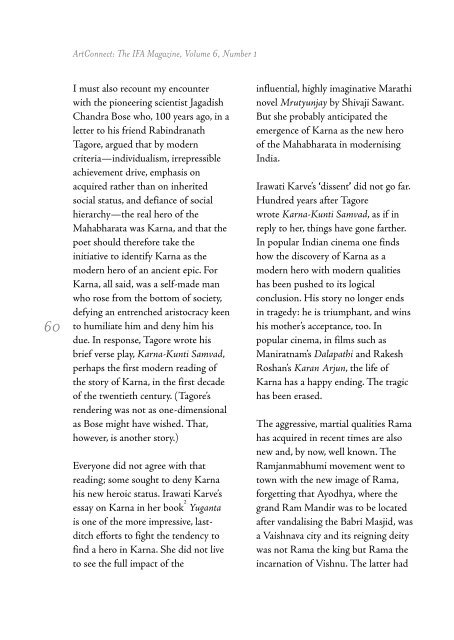Layout 3 - India Foundation for the Arts - IFA
Layout 3 - India Foundation for the Arts - IFA
Layout 3 - India Foundation for the Arts - IFA
You also want an ePaper? Increase the reach of your titles
YUMPU automatically turns print PDFs into web optimized ePapers that Google loves.
60<br />
ArtConnect: The <strong>IFA</strong> Magazine, Volume 6, Number 1<br />
I must also recount my encounter<br />
with <strong>the</strong> pioneering scientist Jagadish<br />
Chandra Bose who, 100 years ago, in a<br />
letter to his friend Rabindranath<br />
Tagore, argued that by modern<br />
criteria—individualism, irrepressible<br />
achievement drive, emphasis on<br />
acquired ra<strong>the</strong>r than on inherited<br />
social status, and defiance of social<br />
hierarchy—<strong>the</strong> real hero of <strong>the</strong><br />
Mahabharata was Karna, and that <strong>the</strong><br />
poet should <strong>the</strong>re<strong>for</strong>e take <strong>the</strong><br />
initiative to identify Karna as <strong>the</strong><br />
modern hero of an ancient epic. For<br />
Karna, all said, was a self-made man<br />
who rose from <strong>the</strong> bottom of society,<br />
defying an entrenched aristocracy keen<br />
to humiliate him and deny him his<br />
due. In response, Tagore wrote his<br />
brief verse play, Karna-Kunti Samvad,<br />
perhaps <strong>the</strong> first modern reading of<br />
<strong>the</strong> story of Karna, in <strong>the</strong> first decade<br />
of <strong>the</strong> twentieth century. (Tagore’s<br />
rendering was not as one-dimensional<br />
as Bose might have wished. That,<br />
however, is ano<strong>the</strong>r story.)<br />
Everyone did not agree with that<br />
reading; some sought to deny Karna<br />
his new heroic status. Irawati Karve’s<br />
essay on Karna in her book 2<br />
Yuganta<br />
is one of <strong>the</strong> more impressive, lastditch<br />
ef<strong>for</strong>ts to fight <strong>the</strong> tendency to<br />
find a hero in Karna. She did not live<br />
to see <strong>the</strong> full impact of <strong>the</strong><br />
influential, highly imaginative Marathi<br />
novel Mrutyunjay by Shivaji Sawant.<br />
But she probably anticipated <strong>the</strong><br />
emergence of Karna as <strong>the</strong> new hero<br />
of <strong>the</strong> Mahabharata in modernising<br />
<strong>India</strong>.<br />
Irawati Karve’s ‘dissent’ did not go far.<br />
Hundred years after Tagore<br />
wrote Karna-Kunti Samvad, as if in<br />
reply to her, things have gone far<strong>the</strong>r.<br />
In popular <strong>India</strong>n cinema one finds<br />
how <strong>the</strong> discovery of Karna as a<br />
modern hero with modern qualities<br />
has been pushed to its logical<br />
conclusion. His story no longer ends<br />
in tragedy: he is triumphant, and wins<br />
his mo<strong>the</strong>r’s acceptance, too. In<br />
popular cinema, in films such as<br />
Maniratnam’s Dalapathi and Rakesh<br />
Roshan’s Karan Arjun, <strong>the</strong> life of<br />
Karna has a happy ending. The tragic<br />
has been erased.<br />
The aggressive, martial qualities Rama<br />
has acquired in recent times are also<br />
new and, by now, well known. The<br />
Ramjanmabhumi movement went to<br />
town with <strong>the</strong> new image of Rama,<br />
<strong>for</strong>getting that Ayodhya, where <strong>the</strong><br />
grand Ram Mandir was to be located<br />
after vandalising <strong>the</strong> Babri Masjid, was<br />
a Vaishnava city and its reigning deity<br />
was not Rama <strong>the</strong> king but Rama <strong>the</strong><br />
incarnation of Vishnu. The latter had


